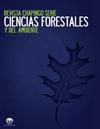Effects of forest management on the physical and hydrological properties of an Umbrisol in the Sierra Madre Occidental
IF 0.6
4区 农林科学
Q3 Agricultural and Biological Sciences
Revista Chapingo Serie Ciencias Forestales Y Del Ambiente
Pub Date : 2020-12-01
DOI:10.5154/r.rchscfa.2019.11.085
引用次数: 4
Abstract
Introduction: Land uses associated with anthropogenic activities affect soil quality negatively. Objective: To determine the effect of regeneration cuts on the physical and hydrological properties of an Umbrisol. Materials and methods: In each stand (parent trees [PT], clear cutting, selection, regenerated area [post-fire] and reference [R]), in situ tests were performed and four samples composed of soil by depth (0 to 20 cm and 20 to 40 cm) were collected. Data were analyzed by Kruskal-Wallis and ANOVA tests. The physical variables (apparent density [AD], porosity, silt, leaf litter and humus, mechanical resistance to penetration [MRP], sand and clay) and hydrological variables (infiltration, field capacity, permanent wilt point, available water and permeability) were related by means of the Spearman correlation coefficient. Results and discussion: Differences were significant (P ≤ 0.01) in MRP, sand and clay in the forest stand factor. For the depth factor, all the variables were similar, except for the MRP; its increase in clear cutting was higher than 100 %, with respect to R. The interaction was only significant (P ≤ 0.01) for the sand percentage. The Kruskal-Wallis test (P ≤ 0.05) indicated that infiltration, humus and litter were lower in clear cutting. There is a significant negative correlation (P ≤ 0.01) of AD with permeability, porosity, clay and sand. PT and clear cuttings increased AD (24.28 and 37.58 %) and MRP (32.59 and 222.22 %), with respect to R. Conclusion: PT and selection cuts did not cause significant variations in properties such as those of a total cut (clear cutting).森林管理对西马德雷山脉一种灌木的物理和水文特性的影响
引言:与人类活动相关的土地利用对土壤质量产生负面影响。目的:确定再生切口对伞状土物理和水文特性的影响。材料和方法:在每个林分(母树[PT]、砍伐、选择、再生区[火灾后]和参考文献[R])中,进行原位测试,并收集四个由深度(0至20厘米和20至40厘米)的土壤组成的样本。数据通过Kruskal-Wallis和ANOVA检验进行分析。物理变量(表观密度[AD]、孔隙度、淤泥、落叶和腐殖质、机械渗透阻力[MRP]、沙子和粘土)和水文变量(渗透、田间容量、永久枯萎点、有效水和渗透率)通过Spearman相关系数进行关联。结果与讨论:MRP、林分因子中砂和粘土的差异有显著性(P≤0.01)。对于深度因子,除了MRP之外,所有变量都是相似的;其净切削量相对于R的增加率高于100%。只有砂率的相互作用显著(P≤0.01)。Kruskal-Wallis检验结果(P≤0.05)表明,清水林的入渗量、腐殖质和枯枝落叶量均较低。AD与渗透率、孔隙度、粘土和砂性呈显著负相关(P≤0.01)。与R相比,PT和透明插条增加了AD(24.28%和37.58%)和MRP(32.59%和222.22%)。
本文章由计算机程序翻译,如有差异,请以英文原文为准。
求助全文
约1分钟内获得全文
求助全文
来源期刊
CiteScore
1.20
自引率
16.70%
发文量
0
审稿时长
>12 weeks
期刊介绍:
The Revista Chapingo Serie Ciencias Forestales y del Ambiente (RCHSCFA) is a scientific journal that aims to raise awareness of high-quality research products related to forest, arid, temperate and tropical environments in the world. Since its foundation in 1994, the RCHSCFA has served as a space for scientific dissemination and discussion at a national and international level among academics, researchers, undergraduate and graduate students, forest managers and public/private entities that are interested in the forest environment.
All content published in the journal first goes through a strict triple-blind review process and is published in the following formats: Scientific Articles, Review Articles, Methodologies, Technical or Technological Notes.

 求助内容:
求助内容: 应助结果提醒方式:
应助结果提醒方式:


